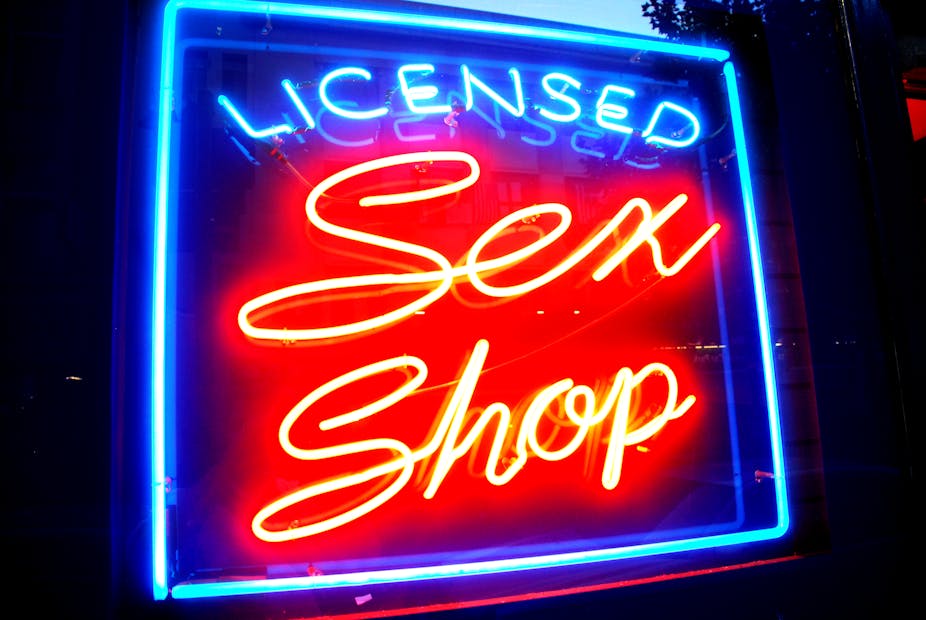The legendary club Madame Jojo’s recently announced that its doors were closing, prompting many to mourn the death of Soho. But the area has been subject to various “clean-up” campaigns throughout its history, with its seedy past being slowly but surely subject to a gradual re-branding, so this sentiment is far from new.
It’s thought that there has been a nightclub on the spot occupied by Madame Jojo’s in Brewer Street since the early 1950s, when Soho was still predominantly a red-light district with an organised crime culture. A famous London venue for drag performances, Madame Jojo’s epitomised the spirit of Soho. Its intimate layout put the performers within touching distance of their audience, and a plush red velvet and ostentatiously gilt-moulded interior combined with a seedy, underworld atmosphere. This heady cocktail made Madame Jojo’s, much like Soho itself, overwhelmingly seductive and repulsive in equal measure.

Sex in Soho
Soho has been at the heart of the capital’s sex industry throughout its colourful history. The area only occupies a square mile, yet its political, economic and cultural reach is considerable – and it continues to have a global association with commercial sex in all its many guises.
Soho has also a long tradition of playing host to a range of migrant groups and (partly because of its culinary and cultural eclecticism and cheap rents) became a fashionable place for intellectuals, writers and artists as well as musicians and film-makers – as the many blue plaques there demonstrate. Now a magnet for consumers, Soho is also a vibrant workplace and thriving residential community, an urban village in the heart of London’s West End.

Before the introduction of the Street Offences Act in 1959, sex workers solicited outside on the streets and in Soho’s many courts and alleyways. There were nearly 100 strip clubs in Soho in its heyday. Since then, sex work has been driven, at least formally, indoors. This has made Soho (relatively) safer for sex workers through the use of CCTV and other security devices, enabling them to screen potential clients before admitting them onto the premises. But this Act (nicknamed “the pimps’ charter”) also meant that as sex workers have moved off the streets, pimps and drug dealers have moved in to take their place.
The 1959 Act also brought with it a proliferation of hostess bars, strip clubs, saunas and massage parlours as premises where sex workers and their clients could be brought together, often by means of an overpriced non-alcoholic drink so that the bar owners could stay within the terms of the law while generating huge profits for themselves and their landlords.
Cleaning up
Westminster City Council have worked hard to close down many of the latter, particularly the so-called “clip joints” that thrived in the wake of the 1959 Act. But Soho not only invites these periodic civic attempts by licensing authorities and community groups to deal with the least savoury aspects of its seedier side. Its character and location means that it is also vulnerable to other forms of commercial co-option, including an increasing corporate re-branding of its “edge”.
Since the 1980s Soho has undergone considerable commercial transformation. In the past two decades or so, the whole area has witnessed something of an urban renaissance, shaped by a combination of licensing regulation, local community initiatives and entrepreneurial activity, particularly the expansion of businesses specialising in new media and communication technologies. Premises deemed suitable for sex-related businesses command inflated rents, a process that has effectively squeezed out many local traders unconnected to the sex industry and many of those who are, but are not protected by a corporate brand.
So the fate of Soho currently seems uncertain, but then it always has. Yet, even though much of the material that is sold in the many sex shops with which the area continues to be associated can now be bought relatively easily and cheaply online, the shops continue to thrive. What attracts their many customers is what social geographers call “the lure of the local” – it is the place itself that draws people to it, at the same time as arguably tainting those who shop and work there with the stigma of the place and the sector. But it is that taint that makes the place what it is – an abject space that simultaneously attracts and repulses.

Soho’s edge
Many think the area is overly gentrified and urbanised. But its chequered history, combined with its reputation as a bohemian place to live, work and consume, means that Soho retains an edge that makes it unique. How long this edge will survive remains open to question. As more businesses are squeezed out by the longer-term impact of online trading, inflated rents and licensing costs, Soho is in perpetual danger of losing itself.
Most recently Soho was subject to a pre-Olympic “clean up” campaign. This project was somewhat counter-balanced by a local branding initiative called “I Love Soho”, sponsored by local businesses concerned to retain the area’s “heart” through the skillful marketing of its café culture. Other local groups and projects such as the Soho Museum provide a counter force to the area’s commercial sanitization, and to the effects that the closure of iconic venues such as Madame Jo Jo’s are likely to have, reminding us that a continuing sense of community can be found only just beneath the surface of Soho’s now ubiquitous coffee chains, family-friendly restaurants and tacky pornographic DVD shops.
As Stephen Fry puts it in his introduction to Bernie Katz’s photographic account of Soho Society, beneath the two public faces of corporate sanitization and sleaze is a private soul of kindness, warmth and connection. Throughout its history, Soho has flourished most when it has been under threat.

